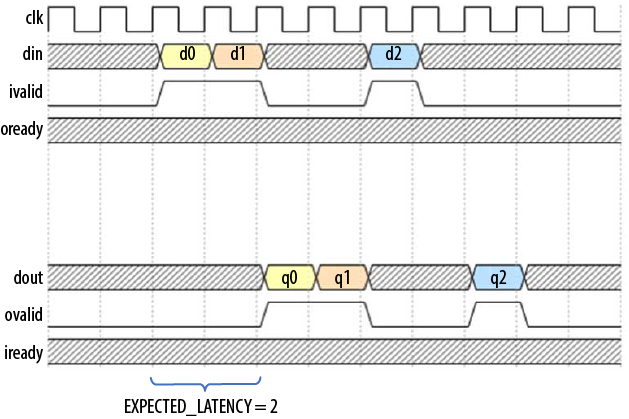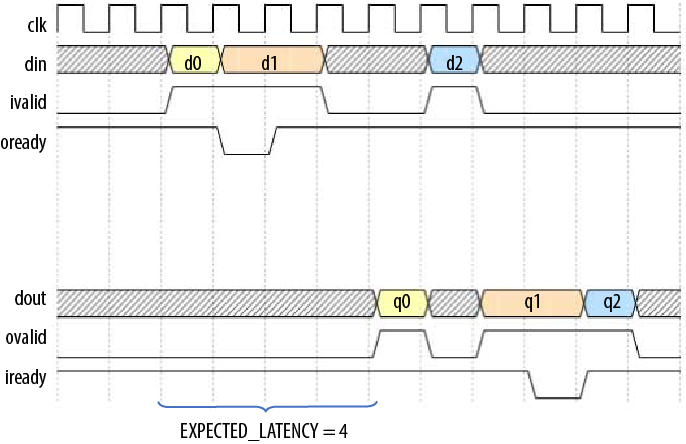Visible to Intel only — GUID: ttz1488403759450
Ixiasoft
Visible to Intel only — GUID: ttz1488403759450
Ixiasoft
11.1.2.5. Avalon Streaming Interface
The offline compiler expects the RTL module to support Avalon® streaming interface with readyLatency = 0, at both input and output.
- ivalid and iready as the input Avalon® streaming interface
- ovalid and oready as the output Avalon® streaming interface

For an RTL module with a fixed latency, the output signals (ovalid and oready) can have constant high values, and the input ready signal (iready) can be ignored.
A stall-free RTL module might receive an invalid input signal (ivalid is low). In this case, the module ignores the input and produces invalid data on the output. For a stall-free RTL module without an internal state, it might be easier to propagate the invalid input through the module. However, for an RTL module with an internal state, you must handle an ivalid = 0 input carefully.
Example Timing Diagram of a Stall-free RTL Component
Consider the following example timing diagram of a stall-free RTL component:

- IS_STALL_FREE value = "yes"
- IS_FIXED_LATENCY value = "yes"
- EXPECTED_LATENCY value = "2"
Example Timing Diagram of a Non-stall-free RTL Component
Consider the following example timing diagram of a stallable RTL component:

- IS_STALL_FREE value = "no"
- IS_FIXED_LATENCY value = "no"
- EXPECTED_LATENCY value = "4"
Performing Advanced Compiler Optimizations
Both ALLOW_MERGING and HAS_SIDE_EFFECTS parameters allow the offline compiler to perform advanced optimizations. Consider the following combinations to understand their impact completely:
| Combination | Description |
|---|---|
| ALLOW_MERGING value = "no" HAS_SIDE_EFFECTS value = "no" |
Each call to an RTL library corresponds to one distinct instance in the hardware. Calls might be optimized away by the compiler if deemed redundant or unnecessary. Calls might be vectorized, with multiple instances in the hardware created for a single RTL library call. |
| ALLOW_MERGING value = "no" HAS_SIDE_EFFECTS value = "yes" |
Each call to an RTL library corresponds to one distinct instance in hardware. Calls are not optimized away by the compiler. The compiler errors out if the attribute num_simd_work_items is greater than 1 for the kernel calling the RTL library. |
| ALLOW_MERGING value = "yes" HAS_SIDE_EFFECTS value = "no" |
Multiple calls to an RTL library might be merged into one call, and hence correspond to one instance in the hardware. Calls might be optimized away by the compiler if deemed redundant or unnecessary. Calls might be vectorized, with multiple instances in the hardware created for a single RTL library call. |
| ALLOW_MERGING value = "yes" HAS_SIDE_EFFECTS value = "yes" |
Multiple calls to an RTL library might be merged into one call, and hence correspond to one instance in hardware. Calls are not optimized away by the compiler. The compiler errors out if the attribute num_simd_work_items is greater than 1 for the kernel calling the RTL library. |